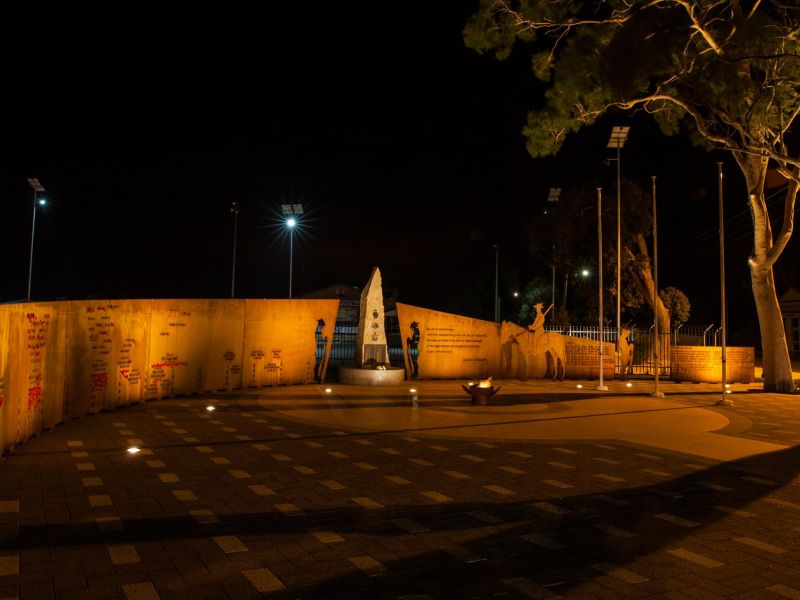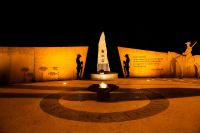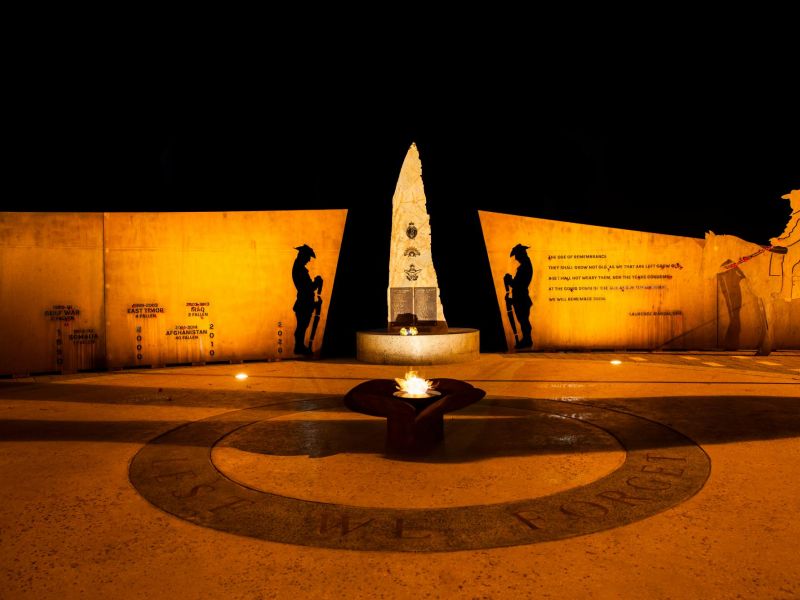The story behind the Harvey War Memorial
In 2011, members of the Harvey RSL Sub Branch approached the Shire with an idea to establish a specific War Memorial in Harvey. Council supported the proposal and included it in its Forward Capital Works Program.
Expressions of Interest were sought to develop the concept and Alexander Planning and Consulting were appointed. The project architect was Jim Alexander.
A working group of Shire and Harvey RSL representatives liaised with the architect to develop a concept plan. It was advertised for public comment.
A major step in the project was determining a suitable site and several were investigated. The location was ultimately chosen due to:
- Its central and prominent position;
- Its proximity to the original War Memorial Library; and
- Being adjacent to the civic precinct of the town, remembering the historic role that the town hall had played in and around the war years.
The aim of the project was to create a unique and contemporary memorial, linking the heritage of the past to our present day community. The intent was to create a new space that was welcoming and respectful, a place that told a story and evoked reflection on the sacrifice of those who served our country.
This memorial seeks to recognise Australia’s involvement in wars and conflicts since Federation.
The Corten wall provides a timeline of those major conflicts. It also highlights some key battles, significant places or events associated with those conflicts which hold a special place in Australian history.
The number of Australians who lost their lives in each war is recorded and if you look closely, you will see perforations in the wall representing the comparative scale of loss suffered in each conflict. Adjacent to WWI and WWII, you will see some much larger perforations which represent the enormous loss of life in those wars. The perforations can also be used to place red poppies tributes.
The wall includes large areas of blank space in the later years of the timeline, indicating two things - the relative time of peace experienced in the last 40 years and, the much smaller loss of life in recent times.
It is hoped that this wall is thought provoking and educational, particularly for our younger generations. It is a reminder of how fortunate we are to live in a period of relative peace and stability - qualities which have been won through extreme earlier sacrifice.
The architect, Jim Alexander, chose roughly cut, central granite rock or obelisk and rusted steel Corten walls to symbolise the harshness of war and the toughness and resilience of our soldiers. The obelisk is guarded by two Australian soldiers and bears the original plaques relocated from the Shire War Memorial Library naming the 21 local men who lost their lives in WWI and the 22 locals killed in WWII.
The badges of the Australian Army, Navy and Airforce are also included.
The second Corten wall includes the “Ode of Remembrance”, a silhouette of an Australian light horseman along with the poem “They left their horses behind”. The horse is significant as only one of the 136,000 Australian horses that returned home after WWI.
The final panel includes the poem “In Flanders Field” which refers to the poppies which we now associate with remembrance. At each end of the Corten walls, the silhouette of a Navy and Airforce serviceman stand guard.
A central point of the memorial is the fire pit which has been crafted in the shape of a poppy. The brick paving includes individual white pavers which have been placed to replicate the lines of headstones found in a military cemetery.
These Corten walls are curved like embracing the community. The walls are dynamic; add water and in some areas it streaks like tears down a face and the rust on the walls bleed when wet.
The large gabian wall to the south of the site contains basalt rocks which are found in the Harvey hills and at the Harvey Dam. They show the strong, local foundations where our soldiers came from.
A major feature of this site is the retention of four large, majestic eucalyptus trees, two of which form a natural gateway to the Memorial. Over time, shrubs planted along the fence will form a hedge as a back drop. Rosemary, another plant synonymous with remembrance, has also been planted.
Finally, the strategic lighting installments focus on the main features of the memorial at night. The beautiful effect helps provide a permanent reminder that this is a special place for our community.
LEST WE FORGET
Speech taken from the official opening, written by Mr Michael Parker, former CEO, Shire of Harvey.

 Harvey War Memorial
Harvey War Memorial